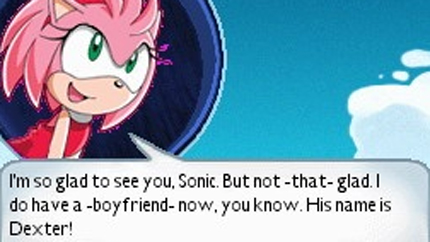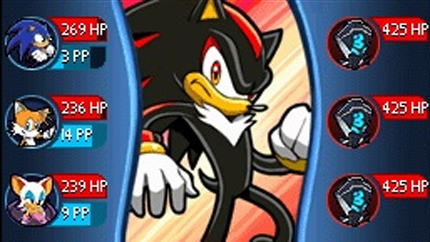Sonic the Hedgehog might not be on the tip of your tongue when you think of role-playing games, but esteemed developer BioWare has blended the two in Sonic Chronicles: The Dark Brotherhood. Shallow fetch quests, an uninteresting plot, and a tiring battle system can leave you bored out of your mind at times, but the game capitalizes on the Sonic universe by including a variety of the franchise's famous characters and makes refreshing use of the touch screen.

BioWare has done a nice job utilizing series lore to re-create Sonic's world. The game opens with the rambunctious Sonic exploring a new land when Tails informs him that Knuckles has disappeared along with the chaos emeralds. Never one to pass up the action, Sonic embarks on a journey to locate Knuckles and collect those pesky emeralds. Along the way you'll meet up with such mainstays as Amy and Shadow, as well as experience BioWare's signature dialogue branches with a fresh Sonic twist. Regrettably, the storyline is distressingly dull and the dialogue options don't impact the gameplay, which is more than mildly disappointing.
Dark Brotherhood's gameplay is very player-friendly, making it a great introduction to the genre. The top screen houses a map marked with stage objectives while tutorials are activated for nearly every gameplay mechanic. Maneuvering Sonic is easily done by touching the screen a short distance in front of him and dragging the stylus to make Sonic run in that direction; however, the controls are slightly less responsive when you're trying to dodge opponents on the field. Those who expect to pair interesting objectives with the game's simplicity will be dissatisfied with its monotonous, effortless fetch quests; even the primary objectives are a cinch. They amount to nothing more than a handful of fights, a switch, and a boss encounter, leaving nothing but touch-screen mastery for a mild challenge.
Much of the gameplay is focused on traversing movement-based puzzles on the field; these puzzles require you to use character-specific movement abilities, like Tails' flight, which is perfect for crossing gaps. This encourages you to cycle through party members to access their different movement abilities; however, you can only do this at your base. This is highly frustrating because it's not always convenient for you to return to base just to exchange party members. You'll also make frequent trips back to base to restore your party because the limited coins you'll encounter on the field force you to conserve expensive healing items and save for gear. You should expect plenty of irksome backtracking in your quest for health points and coinage.
A unique battle system distinguishes Dark Brotherhood from its competition. Rather than utilize the stylus for just menu navigating or field maneuvering, the game incorporates touch-screen prompts for special power move attacks along with a healthy variety of power moves for maintaining interest. Each power move contains several prompt segments that have you tap or follow circles across the screen; and while the prompts initially feel a little strange, you'll quickly find yourself mastering the system. Additionally, enemies with elemental weaknesses add welcome complexity by emphasizing strategic play; you'll have to use the right elemental power moves against foes protected from certain elements.
While the battle system is innovative and starts off feeling dynamic, it quickly becomes wearisome and slow. You can spend four minutes fighting the most basic of disadvantaged opponents because you have to sit through the touch-screen prompts to use or dodge power moves. This gets especially irritating when you progress to formidable opponents with high health and cheap healing abilities, which drains the battle system of any remaining excitement. Moreover, the prompts rarely make much of a difference beyond simply hitting or missing a target. You can nail the prompt for an attack and barely do more damage than if you had missed most of its segments. Or you might miss every portion and still do significant damage, which almost renders the prompts pointless.
Chase segments and chao collecting help alleviate some of the battle system's tedium. The chase segments are enjoyable minigames activated whenever you or your opponent flees from battle; you'll guide your teammates over obstacles in order to escape or catch runaway enemies, and while this event is triggered frequently, it's usually exciting. The chao system allows for additional strategy and character customization, as each chao creature applies a unique effect to its bonded character, such as increased health points. You'll likely enjoy tweaking your party members, as well as adjusting standard character stats, though the game limits stat customization by forcing you to focus on attacks to increase your accuracy--assuming you want to hit anything.
Dark Brotherhood's impressive comic book design pairs remarkably well with Sonic's realm, vividly portraying Sonic's trademark attitude in short dialogue sequences and striking, heavily stylized cutscenes. Detailed 3D character models fluidly maneuver the game's colorful, 2D field displayed on the bottom screen. The models receive an even higher attention to detail on primitive 3D battle environments where they perform power moves with plenty of graphical flash. The music falls far short of offering compelling tracks, but it feels appropriate, providing an adequate backdrop for Sonic's traditional swooshing and buzzing as he dashes through loops or soars through the air.

It should take you a good 15 hours to finish the game's 10 chapters, but most of this time is wasted completing shallow, meaningless tasks or fighting lengthy battles due to the touch-screen prompts. The multicard multiplayer option is a pathetic inclusion that might as well have been left out because it limits you to chao trading in that feverish "collect em' all" spirit; there is no option to battle your friends, which is disheartening considering how well suited the battle system is for competitive multiplayer. You can complete the game a second time, keeping all your unlocked goodies and levels. However, the inability to adjust character stats beyond level 20 and the lack of competitive multiplayer make this a moot point.
Sonic Chronicles: Dark Brotherhood is a decent mix of everyone's favorite hedgehog with the role-playing genre, but you expect a more engrossing storyline and challenging gameplay from a company as experienced as BioWare. As it stands, the game offers little more than touch-screen battle prompts and Sonic nostalgia.